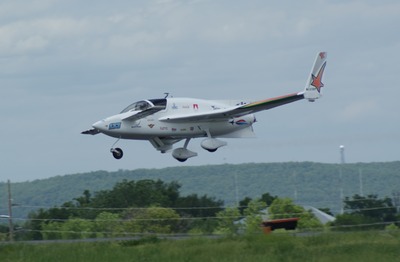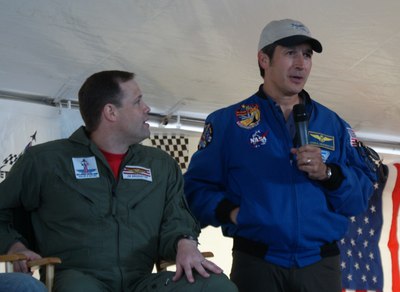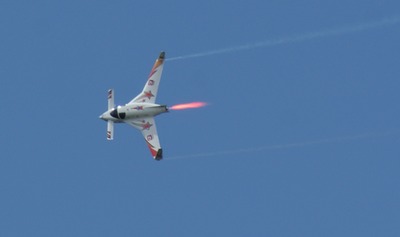Rocket racers, shuttles, and Tulsaby Jeff Foust
|
| “This is a very important event for the city of Tulsa,” Bridenstine said. |
Bridenstine is trying to raise awareness of that heritage and leverage it for the city’s future in the aerospace industry, including its emerging entrepreneurial space sector. The latest step in that effort was Saturday with the QuikTrip Air and Rocket Racing Show, featuring the flights of two X-Racer rocket-powered aircraft by the Rocket Racing League (RRL).
“This is a very important event for the city of Tulsa,” he said at a press conference shortly before the air show started. Bridenstine, who also owns one of the teams in the RRL, lobbied to have the racers come here when he learned the RRL was planning the first public demonstration flights of the league’s two new X-Racers. “This needs to come to the city of Tulsa because of what we’ve done and because of who we are and because of where we want to be in the future.”
There was just one snag in that plan: while the RRL was looking for an air show to host the flights, Tulsa didn’t have one. Thus was born the QuikTrip Air and Rocket Racing Show, which he said was organized in a relatively short time: six months, versus the 12–18 months of planning for a typical air show. “I said, ‘If you come, we’ll make an air show,’ and here, six months later, we’re having an air show,” Bridenstine said.
Much of the air show looked similar to a typical airshow, with wingwalking acts, flights of World War Two-era planes, and overflights by a B-52 and a B-2. But the centerpiece of the event was a pair of flights by the two X-Racers, the first public flights by the RRL since they flew an earlier X-Racer at the EAA AirVenture show in Oshkosh, Wisconsin in the summer of 2008 (see “When will rocket racing take off?”, The Space Review, October 13, 2008).
The air show thus gave RRL an opportunity to re-emerge after a long hiatus. At the time of the Oshkosh show the league had plans for an ambitious series of additional demonstration flights leading up to actual competitive racing among several teams. However, those plans fell by the wayside, and the RRL performed no public flights until Saturday’s show. The league also raised some eyebrows when, just weeks after the successful Oshkosh flights, it announced it was replacing XCOR Aerospace, who developed the engine used on those flights and carried out an extensive flight test program, with Armadillo Aerospace. Last July the league closed a $5.5-million financing round and named a new CEO, Ramy Weitz, replacing co-founder Granger Whitelaw.
The new X-Racers, powered by their Armadillo engines, performed a flawless initial set of flights early Saturday afternoon. Taking off less than a half-minute apart from a runway out of view from the air show audience, the two aircraft quickly zoomed into the skies, using brief engine bursts to perform a series of aerobatic maneuvers before gliding to a landing roughly 10 minutes later.
A couple of hours later, the two aircraft flew again, but this time their flights were cut short, as neither vehicle reignited their engines after their initial takeoff burn, and soon glided back to safe landings. Both vehicles looked to be in good condition when they were rolled out in front of the RRL’s tent on the air show flightline for public viewing.
 An X-Racer glides to a landing at the Tulsa airport during the QuikTrip Air and Rocket Racing Show. (credit: J. Foust) |
RRL spokesperson Diane Murphy said Sunday that the aborted flight was caused by a computer glitch with one of the aircraft. “In the case of T1, the computer shut off the engine, in what was later determined a false alert,” she said, referring to one of the two planes. “In the case of T2, the pilot chose to land early as a safety precaution but it was later determined that both of these cautions were computer related and there were no malfunctions on the part of the aircraft itself.”
| “We really think that this has an opportunity to transform our city,” Bridenstine said. “What I would like to see is the Rocket Racing League have an annual race right here in the city of Tulsa.” |
Despite the glitch, the league chalked up the day’s flights, and the attention they generated, as a major success. The RRL used the event to announce plans for a new rocket racing game for the iPhone that will be available next month. The game allows users to fly X-Racers in a variety of different races, and compete head-to-head with other users. (A version of the game for Apple’s new iPad tablet computer is slated for release in June.) The RRL also used the event showcase technology that will allow them to project a virtual “raceway in the sky” for future RRL flights: as a Cessna airplane used by the league flew overhead, viewers could see it fly through computer-generated virtual gates on a Jumbotron display.
Saturday’s flights are the beginning of a series of public demonstration flights, RRL co-founder and chairman Peter Diamandis said at the show. The league will do a number of increasingly ambitious flights at air shows though the end of next year, expanding the capabilities of the vehicles, before beginning competitive racing in 2012, he said. The RRL has not announced when the next public X-Racer flights will be held; Murphy said Sunday the X-Racers will next perform training flights in Oklahoma, as they did leading up to the Tulsa air show.
|
Video of a portion of an X-Racer flight Saturday in Tulsa. (credit: J. Foust) |
Bridenstine hopes that Saturday’s air show—which attracted more than 40,000 people, at the high end of expectations—is the beginning of a long-term partnership between the city and the RRL. “We really think that this has an opportunity to transform our city,” he said. “What I would like to see is the Rocket Racing League have an annual race right here in the city of Tulsa,” adding that one day he hopes there’s the opportunity to convince the league to move their headquarters to the city.
Tulsa’s space ambitions, though, don’t stop with rocket-powered aircraft. Bridenstine and others there have their eyes set on a much bigger prize: convincing NASA that the city should be home to one of the space shuttle orbiters when the fleet is retired late this year. The city has an effort called “Land the Shuttle” that hopes to show that the Tulsa Air and Space Museum is an ideal home to one of the three orbiters. Throughout Saturday’s air show attendees were reminded of the campaign and invited to sign petitions to be sent to Washington as a sign of support for the city’s bid.
Chairing the Land the Shuttle campaign is former NASA astronaut and Oklahoma native John Herrington. “Having a Space Shuttle in the city of Tulsa would be an incredible inspiration for hundreds of thousands of people: students, parents, educators, everybody,” he said at a Saturday morning press conference.
Tulsa faces stiff competition for an orbiter: nearly two dozen museums and centers are seeking the orbiters, from NASA’s Kennedy Space Center and Johnson Space Center to aerospace museums in New York, Seattle, and Dayton, among others. One of the three—most likely Discovery—will go to the National Air and Space Museum, although it will then transfer Enterprise to another museum.
That competition versus NASA centers and other major museums, plus Tulsa’s relatively low profile, puts the city in the role of an underdog. Some have stepped up their lobbying for an orbiter in a very public way: New York’s Intrepid Sea-Air-Space Museum, ramped up its efforts with a media blitz earlier this month (one newspaper, the Daily News, ran articles about the effort nearly ever day for a week), ranging from endorsements from the state’s two senators to a rally at Grand Central Station were attendees were encouraged “to show their passion for space exploration and dress up as their favorite space themed characters”.
| “I think there’s a good chance” that Tulsa can get one of the retired orbiters, said Sen. Inhofe. “We’re hopeful we’ll be successful and I think we have every chance to do it.” |
Other efforts have been more subtle. Legislation introduced last month in the Senate by Sen. Kay Bailey Hutchison (R-TX) and in the House by Reps. Suzanne Kosmas (D-FL) and Bill Posey (R-FL) to study a potential shuttle extension and related issues about access to the ISS includes a provision about decommissioning of the shuttle fleet. “The remaining orbiter vehicles shall be made available and located for display and maintenance by a competitive procedure,” the section states, “with priority consideration given to eligible applicants meeting all conditions of that plan which would provide for the location, display, and maintenance of one orbiter at or near the Johnson Space Center, in Houston, Texas, and one orbiter at or near the Kennedy Space Center near Titusville, Florida.”
Herrington said that one advantage Tulsa has over other most other sites is that it already has the infrastructure to handle shuttle orbiters. “None of them, with the exception of the Kennedy Space Center, have the infrastructure we have to be able to land the vehicle and offload the vehicle,” he said. The Tulsa Air and Space Museum has plans to build a new facility to host the orbiter, including the capability to move the shuttle from the horizontal to the vertical position. “The money’s not an issue, it’s a question of convincing NASA and convincing Congress that this is a logical location for it,” he said.
 Former astronaut John Herrington (right) talks about the city’s “Land the Shuttle” effort as Jim Bridenstine, executive director of the Tulsa Air and Space Museum, looks on. (credit: J. Foust) |
To that end, Herrington said he and other supporters have been making their case in Washington, meeting and winning support from not only the state’s own congressional delegation but also those from neighboring states (with the exception of Texas, which is backing the Johnson Space Center.) That regional strategy, he said, is “where we have a leg up on a lot of folks.”
Among those in Washington backing that effort is Sen. James Inhofe (R-OK), who, as mayor of Tulsa a quarter-century ago, proclaimed the city as the “aviation capital of America”. “I think there’s a good chance” that Tulsa can get one of the retired orbiters, he said Saturday at the air show. “We’re hopeful we’ll be successful and I think we have every chance to do it.”
Herrington also suggested that NASA owed it to the city to give it a shuttle in recognition of the largely overlooked work companies in the city have done for NASA over the decades. “This is a payback to the city of Tulsa and the workforce here for all the time and effort they put into to making spaceflight and the space station a reality,” Herrington said. “Show your appreciation for the people who have made your effort possible.”
However, people in Florida, Texas, California, and elsewhere can also make the case for “payback” for the efforts they’ve put into the shuttle program over the last several decades. Whether they are recognized for their contributions to the history of spaceflight remains to be seen, but the city is at least taking a step towards playing a role in its future.
